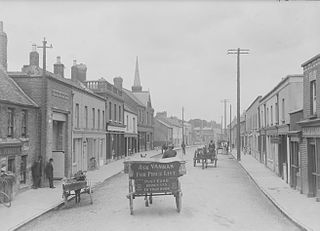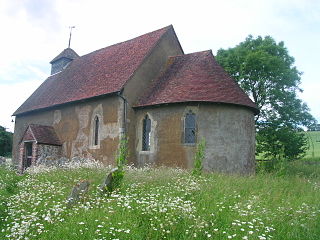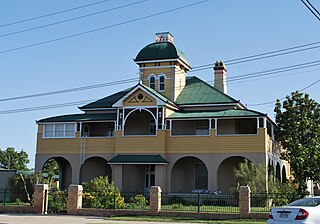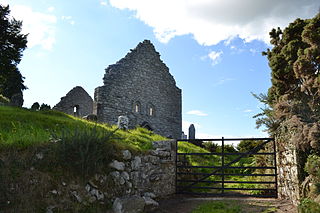
Glendalough is a glacial valley in County Wicklow, Ireland, renowned for an Early Medieval monastic settlement founded in the 6th century by St Kevin. From 1825 to 1957, the head of the Glendalough Valley was the site of a galena lead mine. Glendalough is also a recreational area for picnics, for walking along networks of maintained trails of varying difficulty, and also for rock-climbing.

The N11 road is a national primary road in Ireland, running for 129 km (80 mi) along the east side of Ireland from Dublin to Wexford. It passes close to Bray, Greystones, Wicklow, Arklow, Gorey, and Enniscorthy. Beyond Wexford, the route continues to Rosslare as the N25. The road forms part of European route E01. As of July 2019 the N11/M11 is of dual carriageway or motorway standard from Dublin as far as Oilgate in County Wexford.

Greystones is a coastal town and seaside resort in County Wicklow, Ireland. It lies on Ireland's east coast, 3.5 km (2.2 mi) south of Bray and 24 km (15 mi) south of Dublin city centre and has a population of 18,140 (2016). The town is bordered by the Irish Sea to the east, Bray Head to the north and the Wicklow Mountains to the west. It is the second biggest town in the county.

Rathfarnham is a Southside suburb of Dublin, Ireland. It is south of Terenure, east of Templeogue, and is in the postal districts of Dublin 14 and 16. It is within the administrative areas of both Dún Laoghaire–Rathdown County Council and South Dublin County Council.

The Wicklow Mountains form the largest continuous upland area in the Republic of Ireland. They occupy the whole centre of County Wicklow and stretch outside its borders into the counties of Dublin, Wexford and Carlow. Where the mountains extend into County Dublin, they are known locally as the Dublin Mountains. The highest peak is Lugnaquilla at 925 metres.

Kilmacanogue is a small village in north County Wicklow, Ireland.

Stoke-by-Nayland is a village and civil parish in Suffolk, England, close to the border with Essex. The village, located within Babergh district, has many cottages and timber-framed houses and all surround a recreation field. Possibly once the site of a monastery, the population of the civil parish at the 2001 census was 703, falling to 682 at the Census 2011.

Delgany is a rural village in County Wicklow located on the R762 road which connects to the N11 road at the Glen of the Downs. It is about 25 km (16 mi) south of Dublin city centre. Despite being an older settlement, it is now part of the continuous urban area of Greystones. The area is surrounded by wooded hills and the Glen of the Downs.

Upwaltham is a village and parish in the District of Chichester in West Sussex, England located twelve kilometres (8 miles) north east of Chichester on the A285 road. It is in the civil parish of Eartham. This small parish on the South Downs consists of a small early Norman church and adjoining farmstead in an east–west aligned dry valley in the chalk. There are a few more houses at Benges where the A285 to Chichester leaves the valley. From Benges Hill the parish extends south as far as the disused Roman road of Stane Street, in an area of open access woodland. The barns at Upwaltham House Farm have been converted into a conference and wedding venue. The adjoining farmstead of Littleton Farm is only 2 kilometres (1.2 mi) to the east in the same valley, but lies in Duncton parish.

North Marden is a tiny village on the spur of the South Downs in the Chichester district of West Sussex, England. It is within the civil parish of Marden, West Sussex, 7.5 miles (12 km) northwest of Chichester on the B2141 road.

Up Marden is a small village in the parish of Compton in the Chichester district of West Sussex, England. The former parish was incorporated into the civil parish of Compton in 1933. It is on the South Downs 7 miles (11 km) north-west of Chichester, close to East Marden and North Marden.

Tortington is a small village in the Arun District of West Sussex, England. It lies between the Arundel to Ford and the Arundel to Chichester roads, 1.6 miles (2.6 km) southwest of Arundel.

St Mary's Cathedral is the cathedral church of the Diocese of Tuam, Killala and Achonry in the Church of Ireland. It is located in Tuam, County Galway, in Ireland. From the 12th century until 1839, both before and after the Reformation, it was the seat of the former Archdiocese of Tuam. Most of the present structure dates from the 1870s, but parts of earlier 12th- and 14th-century structures survive within.

The Church of the Transfiguration is the Church of England parish church of the village of Pyecombe, in the Mid Sussex District of West Sussex, England. The mostly 12th- and 13th-century building, in an isolated setting facing the South Downs, has been designated a Grade I Listed building.

St Mary's Church is a redundant Anglican church in the village of Little Hormead, Hertfordshire, England. It is recorded in the National Heritage List for England as a designated Grade I listed building, and is under the care of the Churches Conservation Trust. The church is particularly noted for its Norman door, made of wood and ironwork. It is described as a "work of outstanding importance", and a "rare and precious survival".

St Mary's Church, Llanfair-yng-Nghornwy is a medieval parish church in the north-west of Anglesey, north Wales. The date of foundation of the church, which is in the village of Llanfair-yng-Nghornwy, is unknown, but the oldest parts date from the 11th or 12th century. It has twice been enlarged: in the 15th century, when the chancel was rebuilt, and in the 16th century, when a chapel was added to the south of the chancel, separated by three arches. The tower at the west end is from the 17th century. A south porch of unknown date has been converted into a vestry, and the church is now entered through the tower.

St John the Evangelist's Church is a Grade I listed Church of England parish church dedicated to John the Evangelist, in Corby Glen, Lincolnshire, England. The church is 9 miles (14 km) south-east of Grantham, and in the South Kesteven Lincolnshire Vales. It is noted in particular for its 14th- and 15th-century medieval wall paintings.

St Mary's Catholic Church is a heritage-listed Roman Catholic church at 20 Merivale Street, South Brisbane, Queensland, Australia. It was designed by Simkin & Ibler and built from 1892 to 1929. It was added to the Queensland Heritage Register on 3 December 2004.

St Mary's Presbytery is a heritage-listed Roman Catholic presbytery of St Mary's Roman Catholic Church at 142 Palmerin Street, Warwick, Southern Downs Region, Queensland, Australia. It was designed by Wallace & Gibson and built from 1885 to 1887 by John McCulloch. It is also known as Father JJ Horan's private residence. It was added to the Queensland Heritage Register on 31 July 2008.

Aghowle Church is a medieval church and National Monument in County Wicklow, Ireland. Aggowle is also a civil parish in the ancient barony of Shillelagh.





















